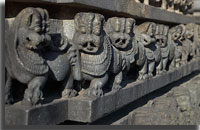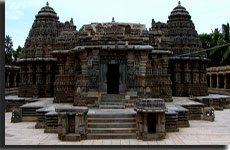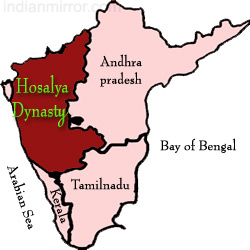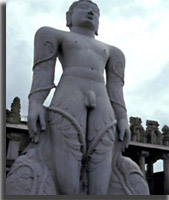History :
Hoysala Dynasty was a prominent South Indian Kannadiga empire that ruled most of modern day state of Karnataka from 10th to 14th centuries. Initially the capital of the Hoysalas was located at Belur but was later moved to Halebidu. The Hoysalas were originally hill people of Malnad Karnataka, an elevated region in the Western Ghats range. In 12th century, taking advantage of the warfare between the then Western Chalukyas and Kalachuri kingdoms, they also took over present day Karnataka and the fertile areas north of the Kaveri River delta of the present day Tamil Nadu. By 13th century, they governed most of present-day Karnataka, minor parts of Tamil Nadu and parts of western Andhra Pradesh in Deccan India.
Standing on the top of Bennegudda hill, it is really interesting to view in every direction. Spreading to the north we find the ruins of ancient city of Dwarasamudra and its temples of stone. The city of Dwarasamudra that once encompassed of Bennegudda was built by the kings of thousand-year old Hoysala Dynasty. The Hoysalas came into existence in the period when the Chalukya Kings dominated the northern parts of Karnataka, while their was struggle between the Cholas and Gangas for dominion in the south.

the famous Hoysaleshwara Temple and the large lake of the Hoysala Dynasty attract travellers in drones from all over the world. South, not far from Hoysaleshwara Temple, is another complex of finely carved structures of stone that have weathered the times. Finally west is an open expanse of villages and fields, with tall hills of Western Ghats visible in the horizon.

South of Hoysaleshwara temple is the smaller Kedareshwara temple, which shares architectural elements with its neighbour. While the former is buzzing with activity of tour groups and guides, Kedareshwara Temple has a deserted calm, allowing the visitor to explore at one's own pace.

Place |
Karnataka |
Period |
10th to 14th Century |
Language |
Kannada |
Religion |
Hindu |
Kings |
Nripa Kama II, Hoysala Vinayaditya, Ereyanga, Veera Ballala I, Vishnuvardhana, Narasimha I, Veera Ballala II, Vira Narasimha II, Vira Someshwara, Narasimha III, Veera Ballala III
|
Administration
The framework of Hosalya Dynasty was inherited from Chalukyas. The Hosalyas divided the kingdom into Nadus, Kampanas, Vishayas and Deshas. The officer who managed small territories units like nadus in the kingdom were called as Nadaprabhu, Nadagauda and Nadasenabhova. Each was governed by a minister called Mahapradhana who headed the local body. The treasure Bhandari who reported to the province was known as Dandanyaka. Dandanyakas were in responsible for charge of armies and the chief justice namely the Dharmadhikari of the Hoysala Court. The supervisors or officials Heggaddes and Gavundas used to supervise the local farmers and labourers. The person who looked after the towns and who had both civil & military functions was called the Pattanaswami.
Economy

Religion
The Hoysalas followed Hinduism along with Jainism and Buddhism. We can find the evidence in the Jain Places in Shravanbelagola and Kambadahalli. The important inspired Philosphers Basavvana, Madhavacharya and Ramanajacharya spotted the religious movements which are found in Hoysala rule. Hoysalas were the most powerful and had great valour.The Dynasty is known for its intense blend of bravery and cultural richness which is an epitome in the history of India.


